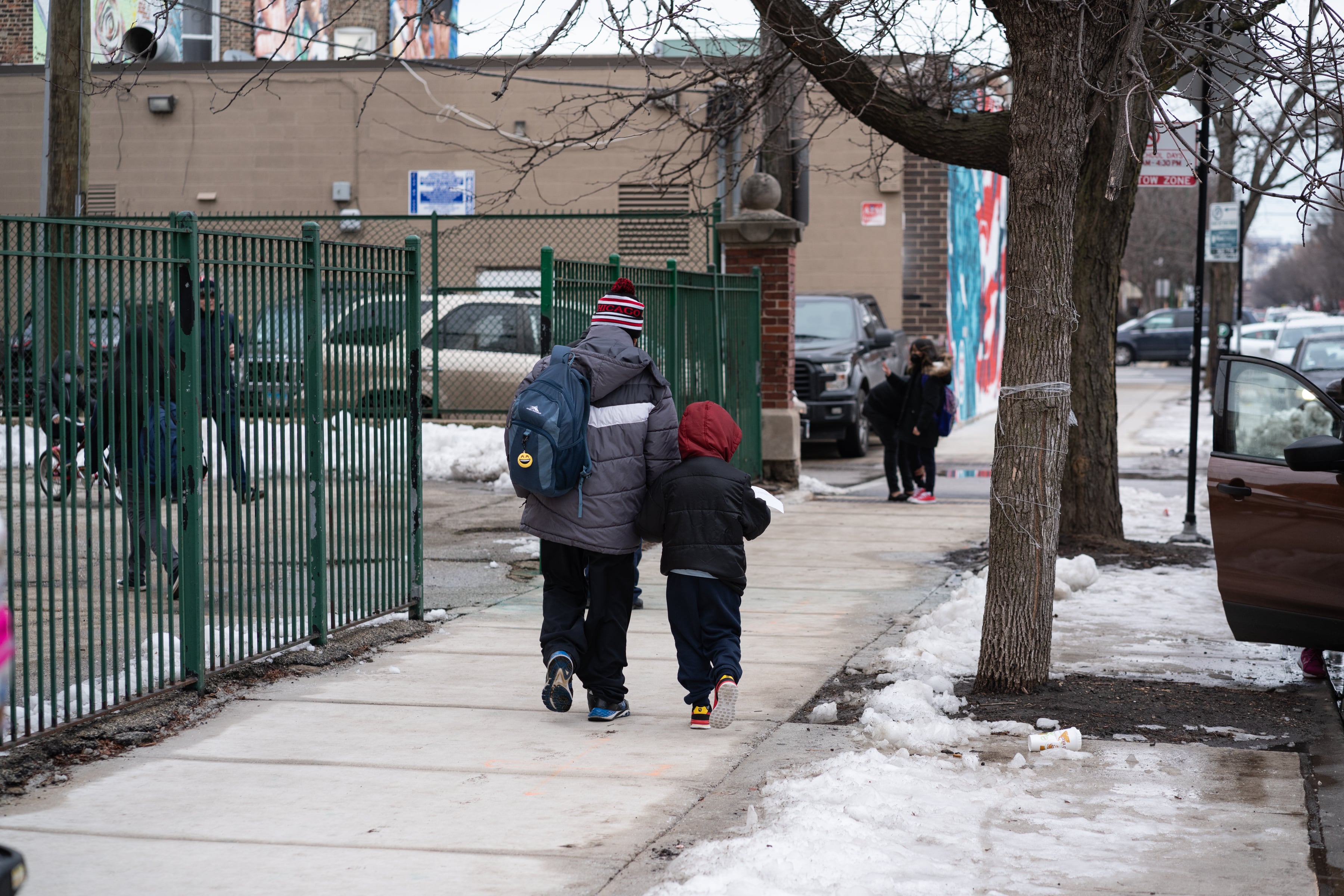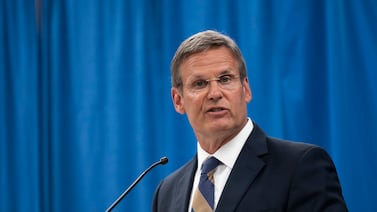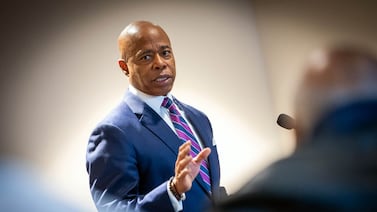At Perkins Bass Elementary on Chicago’s South Side, principal Carolyn Jones has welcomed an infusion of federal COVID relief dollars that brought a second school counselor, a new social and emotional learning curriculum, and classroom technology upgrades.
But at some Chicago schools, principals are questioning why a good chunk of the $2.8 billion in federal funding the district received for use over three years is paying for existing staff — and what the district is doing with the money it is saving as a result.
Data obtained by Chalkbeat shows the district swapped out millions in these federal pandemic relief dollars for state and other funds previously budgeted for educator and support staff salaries and benefits. The district has previously spelled out plans to pay for existing positions with the money. But the campus-level data through January from the district’s accounting system is the first glimpse at real-time spending midyear, and it took some school leaders by surprise.
District officials have said that steering federal relief dollars toward teachers and other staff allowed it to pump more money into campus budgets this school year. Some principals say they have felt and appreciated the extra budgetary breathing room they got despite steep enrollment losses, which typically would result in cuts to their school per-pupil allocations.
As Jones notes, the staffing expenses are only a portion of more than $1 billion in federal Elementary and Secondary School Emergency Relief, or ESSER, funds the district budgeted this year, which are also going toward academic and mental health interventions, COVID mitigation measures, and other support.
But other school leaders say too much of this historic influx of federal funds meant to help schools bounce back from the pandemic’s disruption is going toward run-of-the-mill staffing expenditures. As the district gears up to unveil its campus budgets for the next school year, leaders said they crave a larger infusion of flexible dollars to address pressing needs and ensure students don’t fall further behind.
“There is an unbelievable, heartbreaking need in our schools — right now,” said one elementary principal, who like some of his colleagues spoke with Chalkbeat anonymously because they did not have the district’s permission to discuss the issue. “This money was supposed to give us more, but instead it’s giving us the same.”
Overall, despite the enrollment declines, the district’s fiscal outlook remained fairly stable this year, leading some educators to ask whether it needs to use much of its COVID relief dollars to supplant previously planned staffing expenses. Some wonder if it’s socking away some of the money for looming financial uncertainty, or giving CEO Pedro Martinez, who arrived after the start of the school last fall, more flexibility to tailor his own spending plan. He said last week he will soon unveil a new three-year vision for the district.
The data Chalkbeat obtained does not offer a complete picture of spending. The district budgeted a major portion of the funds this year in central pots from which schools draw, but it appears that this spending is not yet classified as ESSER expenditures in accounting system data. The district said a fuller campus-by-campus picture of spending will emerge at the fiscal year’s end.
Federal relief dollars cover big portions of some school budgets
Based on the data, the district put $446.2 million of the almost $1.1 billion in ESSER dollars this year directly into its schools’ budgets. Schools got a fraction, about $47 million, as flexible “unfinished learning” dollars last summer for principals to spend as they saw fit. The bulk of federal dollars in school budgets arrived later last fall, replacing previously budgeted funds for staffing and other essential expenditures.
Another $403 million was budgeted for various districtwide departments. Charters got almost $53 million, and the district was required to pass on a small portion of the money to private schools.
Overall, the district and its campuses had spent $381 million on salaries and benefits — mostly existing positions — by midyear, including a small portion for substitute salaries. Other, much smaller categories are $27 million for equipment, with the biggest chunk going toward computers and other technology, and supplies, at $26 million.
Spending appeared to be proceeding at a different pace from school to school. Some campuses had spent almost all their budgeted ESSER dollars while others, including district-run and contract alternative high schools, had barely started spending.
District leaders have noted that anticipating the influx of federal dollars, Chicago put $225 million more into school budgets last spring, despite marked pandemic-era enrollment losses. In applications for the latest two rounds of federal funding the district submitted to the state, it said it would use about $764 million to pay for existing instructional positions. It would also cover some support staff and pre-kindergarten personnel with these dollars.
Still, several principals who reviewed the data for their schools said they were surprised to see how much of their staffing budgets is now covered out of the district’s ESSER fund.
The Chicago elementary principal said he strongly agreed when district leaders cautioned last summer against hiring many new staffers with the money. Schools would be forced to let those new employees go when the money runs out in the fall of 2024, causing disruption to students and school communities.
But he said his thinking on the issue changed as the school year got underway and his campus faced the profound academic and mental health needs of students returning from 18 months of disrupted learning and trauma.
The return to full-time in-person learning amid staffing shortages, COVID surges, and other setbacks has been more challenging than many educators expected, he said. Bringing in more adults, even if it’s only in the short term, can help kids bounce back.
In mid-October, Chicago Public Schools told principals it would shift some of their schools’ budgeted spending to the district’s COVID relief fund. The shift was in keeping with the district’s multi-year strategy to make use of those dollars, the note said. Their budgets wouldn’t change and they didn’t have to do anything.
Still, that principal said it was jarring to see more than $1 million in ESSER dollars replacing other funds previously budgeted for existing staff and supplies in the Chalkbeat data he reviewed. That amount surpasses other help his school got with the federal dollars: COVID mitigation measures, student reengagement funds, and a new social and emotional learning curriculum that arrived after the school year started.
He would use the money to hire a social worker or other support staff, reduce class sizes, and place more special education classroom assistants in the school.
“This makes me so angry,” he said. “The idea that there could be more people helping in our schools right now, and there aren’t, just kills me.”
Another elementary principal, who also expressed surprise that the district had replaced previously budgeted staffing funding with ESSER dollars, wishes more of the federal money was flexible.
School communities have a much better handle on their students’ needs than they did on the eve of this school year. The principal said would like to steer more dollars toward ongoing efforts to re-engage students, including by giving them more of a voice in school decisions. She said schools like hers are still scrambling to address students’ social and emotional needs so they can tackle academic catch-up in earnest.
“I don’t think people realize just how dire some of the situations we have seen can be,” she said.
Some principals tout ‘quality investments’
But other principals said the district is doing a good job stewarding the federal resources.
At Perkins Bass, more than $1 million in ESSER dollars is now in the school’s $3.4 million budget, largely to cover existing positions.
But Jones, the principal, says the school separately received much more help through the federal funding influx. As part of the district’s two-year Moving Forward Together pandemic recovery initiative, the school got a second counselor — one of 64 new counselor positions the district is adding this year and next.
Perkins Bass also got three early literacy tutors — part of a new Tutor Corps the district launched this fall — and an academic interventionist to guide their work. Although it took a while to hire and train that team, the effort will be in full swing this semester. Also new: a post-secondary counselor, 250 new devices to replace those lost or damaged during remote learning; and upgrades to classrooms.
“All these materials were provided without touching any of our building dollars — things that are invaluable resources,” Jones said. “There have been some thoughtful, quality investments made on our behalf.”
The school also used the flexible “unfinished learning” dollars in its budget for reengagement efforts earlier in the school year: family events, book bags, and Friday attendance incentives such as ice cream and popsicles for students.
“This money went to bring back the j-factor — the joy of school,” Jones said.
One principal at a high-needs high school said that besides the dollars covering existing staff at his school, he can only point to a few new investments with these federal COVID funds.
But he said this has also been a largely worry-free year when it comes to his school’s budget. Despite a drop in the school’s enrollment last spring, the campus did not take a budget hit, giving it some breathing room as it serves fewer students with slightly more dollars.
“They could have taken away per-student money, but they did not,” he said. “That has helped a lot. They let us off the hook for a while to regroup and rebound. I’m in a really good spot financially.”
The district provided a brief statement in response to questions from Chalkbeat.
“Chicago Public Schools is committed to making the best use of all funding aligned to district priorities, eligible expenses, and timing constraints,” the statement said in part, explaining that reclassifying expenditures in various district funds can happen routinely throughout the school year.
Chicago faces financial uncertainty
Experts tend to agree that no simple, foolproof prescriptions exist for making use of federal COVID relief dollars — a major windfall for districts, but ultimately onetime influxes that they must spend by fall of 2024.
Ralph Martire of the Illinois-based Center for Tax and Budget Accountability notes the federal government gave districts a lot of discretion on how to spend the dollars. One suggested use is retaining employees who might face looming layoffs. But he notes that Chicago’s teachers and other staff did not appear in danger of imminent layoffs this year. The district’s state revenue dipped, but that decrease was more than offset by an increase in local tax revenue. However, projected expenditures rose as well, including for employee salaries and benefits.
“I don’t see how you can make the argument that you need to use this money to avert layoffs because there was no dip in district revenue,” he said. “The federal money is freeing up state and local revenue for other purposes. If this is supplanting, what’s happening with the other revenue?”
Laura Anderson, associate director at the Edunomics Lab, a research center at Georgetown University focused on school finance, said districts’ reluctance to go big on new hires they might not be able to afford in the long run is understandable.
Still, Anderson said that at some schools that serve students from low-income families, bringing in more staffers in the short term to address pressing student needs might be a valid approach — as long as officials are clear that these are two-year temporary positions. But she cautions that these educators and other staff would still build relationships with students that would eventually have to be severed unless those new staff can fill positions left open by attrition.
“I understand the argument of, ‘We need to get the adults in the building, with all the credentials — now,’” she said. “Communication is the key point. But in the end, it’s still going to hurt.”
Another Chicago elementary principal said he appreciates that the federal dollars might help ward off per-student budget cuts. But he worries the backfilling can create a false sense of complacency. In addition to underwriting existing positions, his school got math and reading coaches through an outside vendor as part of Moving Forward Together.
The district must have an unflinching discussion with school leaders about what budgets will look like in 2024 without an enrollment reversal and without any more federal funds, the principal said.
Schools need to kick off enrollment campaigns to try to get back students lost to private schools and home schooling, especially in the early grades. And they need to start having tough conversations about adapting to a shrinking student body, including the possibility of sharing some programs and support staff positions, the principal said.
“There are just not enough kids in the district any more to justify the budgets schools have,” he said. “The district can’t just say, ‘We’ll have a reckoning down the road.’”
There’s also the question of what will happen with unspent ESSER funds this year.
Jones, the Perkins Bass principal, and other school leaders noted schools also received significant allocations earmarked for after-school and summer programs — more than many campuses will likely be able to spend.
Jones said the ongoing pandemic hampered efforts to beef up after-school programs amid staffing challenges, lower family interest, and student quarantines. Between the ESSER out-of-school time dollars and a separate grant for after-school programming, the school got almost $450,000.
“Right now, we’re really in a state of what’s to come because it’s almost budget time, and we have no clue if this money is going to roll over into next year,” Jones said. “If it does, it would make budget season joyous and celebratory. If not, we’ll be back to biting our fingernails to figure out how to make everything fit.”
Mila Koumpilova is Chalkbeat Chicago’s senior reporter covering Chicago Public Schools. Contact Mila at mkoumpilova@chalkbeat.org.









